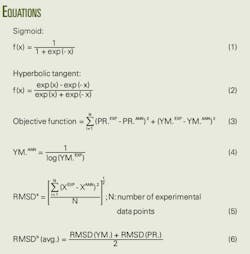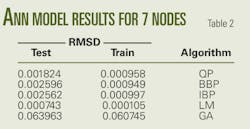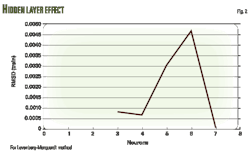Neural network estimates Poisson's ratio, Young's modulus
A study compared various artifical intelligence techniques for determining Poisson's ratio and Young's modulus. These techniques provide an alternative, less costly method for determining mechanical properties of rocks.
This study used 602 data points from lab measurements and log data. The data were randomized and cut into three equal sets, one for training, the second for validation, and the third for blind testing the evolved model.
The evolved model's estimates of Poisson's ratio and Young's modulus had a good accuracy with a correlation coefficient (R2) of 0.9808.
The study used different artificial intelligence techniques to estimate Poisson's ratio and Young's modulus as a function of depth with lab porosity, overburden stresses, pore pressure, minimum horizontal stress measurements, and log data such as bulk density (RHOB), sonic DT compressional, and sonic DT shear.1
Rock mechanics
Rock mechanics concerns the response of rock to the forces in its physical environment.
In hydraulic fracturing, rock mechanics is important for determining mechanical properties and in situ stresses of reservoir rock, calculating deformation and failure behavior of the rock caused by the treatment, and determining the final fracture geometry.2-5
Mechanical properties often are obtained in the laboratory from cores, but the lab measurements are expensive and time consuming.
As an alternative, the industry has available many correlations and models for estimating mechanical properties using some lab measurements data.
Artificial neural networks
The artificial neural network is a mathematical method to find an empirical relationship between the inputs and outputs of system. One can apply ANN models for classification, correlation, prediction, and control.
An ANN model contains one input, one output layer, and one or more hidden layers. Each layer has several nodes connected by weight coefficients (w) and biases (b).6 One can consider both weight coefficients and biases as adjustable parameters.
The two stages of an ANN model are the training and testing processes. It should be mentioned that the model learns the training process with a trial-and-error method.
The neural network method is a simple model that the oil and gas industry uses widely.
Recently, Pazuki et al. used these systems to predict asphaltene precipitation in crude oil,7 calculate surface tension of pure hydrocarbons,8 and predict compressibility factors for sour and natural gas.9
The study discussed in this article models Poisson's ratio and Young's modulus parameters for various types of rocks with an artificial neural network. It uses the hyperbolic tangent and sigmoid transfer functions as the hidden and output layers (Equations 1 and 2 in the equation box).
One can obtain the weights and biases with a minimization of the objective function (Equation 3).
In the equation, N is the number of experimental data points and PR and YM are Poisson's ratio and Young's modulus, respectively.
The superscripts EXP and ANN stand for experimental and artificial neural networks. One can obtain the structure of ANN by using MATLAB 7 software.
Calculations
The PR and YM properties depend on depth (ft), porosity (%), bulk density RHOB (gr/cc), DT compressional (µsec/ft), DT shear (µsec/ft), overburden stresses (psi), pore pressure( psi), and minimum horizontal stress (MPa).
The study applied Equation 4 to Young's modulus selectivity as the output layer:
The experimental data for the study came from literature.10 Table 1 shows the rock mechanics data used.
Methods used in the simulations include the batch-batch propagation (BBP), quick propagation (QP), genetic algorithms (GA), incremental back propagation (IBP), and Levenberg-Marquardt (LM).
The ANN used 602 experimental data points of which 70% were for training and 30% for testing. The ANN used a feed-forward structure for obtaining PR and YM (Fig. 1).
Table 2 shows the simulation results for the various training algorithms used.
As seen from Table 2, the Levenberg-Marquardt training algorithm provides the best results.
Fig. 2 shows the performance of the Levenberg-Marquardt algorithm with different hidden layer neurons. It should be emphasized that the study used the values of the root mean square deviation (RMSD).
RMSD can be defined as the variations of the experimental data of Poisson's ratio and Young's modulus parameters against the ANN model predictions represent in Figs. 3 and 4.
These figures show that the results of the ANN are in agreement with the experimental data.
References
1. Chang, C., et al., "Empirical Relations Between Rock Strength Physical Properties in Sedimentation Rocks," Journal of Petroleum Science and Engineering, No. 51, 2006, p. 2231.
2. Clark, P.E., et al., "Design of a Large Vertical Prop Transport Model," Paper No. SPE 6814, SPE ATCE, Denver, Oct. 9-12, 1977.
3. Gidley et al., Recent Advances in Hydraulic Fracturing, SPE Monograph 12, Richardson, Tex., 1989.
4. Bharucha, V.F., Rheological Study of Hydroxypropyl Guar (HPG) Slurries, MSc Thesis, Norman, Okla.: University of Oklahoma, 2004.
5. Al-Awad, M.N.J., "Rock Mechanics Applications In Petroleum Engineering Practices," Oil and Gas European Magazine (International Edition of ERDOIL ERDGAS KOHIL), Germany, Vol. 4, No.1 , pp. 18-20, December 1998.
6. Hagan, M.T., et al., Neural network design, Pacific Grove, Calif.: PWS Publishing, 1996.
7. Pazuki, G.R., et al., "Prediction of Asphaltene Precipitation in Crude Oil," Journal of Petroleum Science and Engineering. No. 68, 2009, p. 218.
8. Pazuki, G.R., et al., "Prediction of Surface Tension of Pure Hydrocarbons by Artificial Neural Network System," Journal of Petroleum Science and Technology, in press, 2010.
9. Pazuki, G.R., et al., "Prediction of Compressibility Factor of Sour and Natural Gas by an Artificial Neural Network System," Journal of Petroleum Science and Technology, in press, 2010.
10. Al-Anazi, B.D., Personal Communications, 2009.
The authors
More Oil & Gas Journal Current Issue Articles
More Oil & Gas Journal Archives Issue Articles
View Oil and Gas Articles on PennEnergy.com










